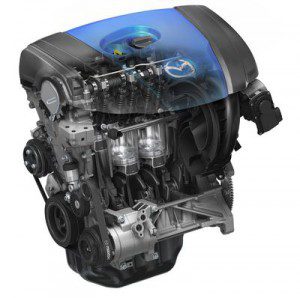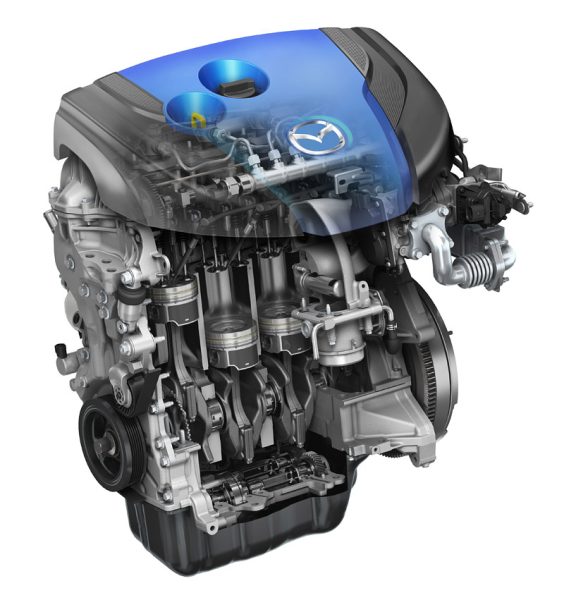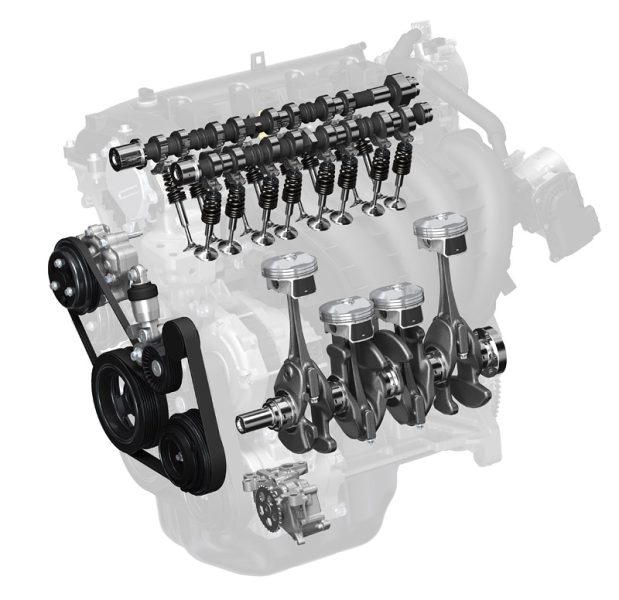
Mazda SkyActiv G engine - petrol and SkyActiv D - diesel
 Automakers aim to reduce CO emissions2 differently. Sometimes it is, for example, o Compromises that shift the joy of driving to the sidelines. However, Mazda has decided to go in a different direction and cut emissions with a new all-in-one solution that doesn’t take away the pleasure of driving. In addition to the new design of gasoline and diesel engines, the solution also includes new chassis, body and gearbox. Reducing the weight of the entire vehicle goes hand in hand with new technology.
Automakers aim to reduce CO emissions2 differently. Sometimes it is, for example, o Compromises that shift the joy of driving to the sidelines. However, Mazda has decided to go in a different direction and cut emissions with a new all-in-one solution that doesn’t take away the pleasure of driving. In addition to the new design of gasoline and diesel engines, the solution also includes new chassis, body and gearbox. Reducing the weight of the entire vehicle goes hand in hand with new technology.
Recent studies show that conventional combustion engines will continue to dominate the automotive world for the next 15 years, so it is worth continuing to invest a lot of effort into developing them. As you know, most of the chemical energy contained in the fuel is not converted into mechanical work during combustion, but literally evaporates in the form of waste heat through the exhaust pipes, radiator, etc. and they also explain the losses caused by friction of the mechanical parts of the engine. In developing the new generation of SkyActiv gasoline and diesel engines, engineers from Hiroshima, Japan, focused on six main factors that affect the resulting consumption and emissions:
- compression ratio,
- fuel to air ratio,
- the duration of the combustion phase of the mixture,
- the time of the combustion phase of the mixture,
- pumping losses,
- friction of the mechanical parts of the engine.
In the case of gasoline and diesel engines, compression ratio and friction loss reduction have proven to be the most important factors in reducing emissions and fuel consumption.
Engine SkyActiv D
The 2191 cc engine is equipped with a high pressure common rail injection system with piezoelectric injectors. It features an unusually low compression ratio of just 14,0: 1 for diesel. Recharging is provided by a pair of turbochargers of different sizes, which has a positive effect on reducing the delay in engine response to pressing the accelerator pedal. The valve train includes variable valve travel, which warms up faster when the engine is cold, as some of the exhaust gases return to the cylinders. Due to reliable cold starting and stable combustion during the warm-up phase, conventional diesel engines require a high compression ratio, which is typically in the range of 16: 1 to 18: 1. The low compression ratio of 14,0: 1 for the SkyActiv-D engine allows optimize the time of the combustion process. As the compression ratio decreases, cylinder temperature and pressure also decrease at top dead center. In this case, the mixture burns longer even if fuel is injected into the cylinder just before reaching top dead center. As a result of prolonged combustion, areas with a deficiency of oxygen are not formed in the combustible mixture, and the temperature remains uniform, so that the formation of NOx and soot is significantly excluded. With fuel injection and combustion near top dead center, the engine is more efficient. This means more efficient use of the chemical energy contained in the fuel as well as more mechanical work per unit of fuel than in the case of a high compression ratio diesel engine. The result is a reduction in diesel consumption and logical CO2 emissions by more than 20% compared to a 2,2 MZR-CD engine operating with a 16: 1 compression ratio. As mentioned, much less nitrogen oxides are generated during combustion and almost no technical carbon. Thus, even without an additional NOx removal system, the engine meets the Euro 6 emission standard due to come into force in 2015. Thus, the engine does not need selective catalytic reduction or a NOx eliminating catalyst.
Because of the low compression, the engine cannot generate a high enough temperature to ignite the mixture during cold starts, which can lead to very problematic starting and engine intermittent operation, especially in winter. For this reason, SkyActiv-D is equipped with ceramic glow plugs and a variable stroke VVL exhaust valve. This allows hot exhaust gases to be recirculated internally in the combustion chamber. The first ignition is assisted by a glow plug, which is sufficient for the exhaust gases to reach the required temperature. After starting the engine, the exhaust valve will not close like a normal intake engine. Instead, it remains ajar and the hot exhaust gases return to the combustion chamber. This raises the temperature in it and therefore facilitates the subsequent ignition of the mixture. Thus, the engine runs smoothly and without interruption from the first moment.
Compared to the 2,2 MZR-CD diesel engine, internal friction has also been reduced by 25%. This is reflected not only in a further reduction in overall losses, but also in faster response and improved performance. Another benefit of a lower compression ratio is lower maximum cylinder pressures and therefore less stress on individual engine components. For this reason, there is no need for such a robust engine design, resulting in further weight savings. The cylinder head with integrated manifold has thinner walls and weighs three kilograms less than before. The aluminum cylinder block is 25 kg lighter. The weight of the pistons and crankshaft has been reduced by another 25 percent. As a result, the overall weight of the SkyActiv-D engine is 20% lower than that of the 2,2 MZR-CD engine used so far.
The SkyActiv-D engine uses two-stage supercharging. This means it is equipped with one small and one large turbocharger, each operating at a different speed range. The smaller one is used at low and medium revs. Due to the lower inertia of the rotating parts, it improves the torque curve and eliminates the so-called turbo effect, that is, the delay in the engine's response to a sudden accelerator jump at low speed when there is not enough pressure in the exhaust. branch pipe for quick turning of the turbocharger turbine. In contrast, the larger turbocharger is fully engaged in the mid-speed range. Together, both turbochargers provide the engine with a flat torque curve at low rpm and high power at high rpm. Thanks to the sufficient air supply from the turbochargers over a wide speed range, NOx and particulate emissions are kept to a minimum.
So far, two versions of the 2,2 SkyActiv-D engine are being produced for Europe. The stronger one has a maximum power of 129 kW at 4500 rpm and a maximum torque of 420 Nm at 2000 rpm. The weaker one has 110 kW at 4500 rpm and a torque of 380 Nm in the range 1800-2600 rpm, at max. the speed of both engines is 5200. In practice, the engine acts rather lethargic up to 1300 rpm, from this limit it starts to gain speed, while for normal driving it is enough to maintain it at about 1700 rpm or more even for the needs of smooth acceleration.

SkyActiv G engine
The naturally aspirated petrol engine, designated Skyactiv-G, has an unusually high compression ratio of 14,0:1, currently the highest in a mass-produced passenger car. Increasing the compression ratio increases the thermal efficiency of the gasoline engine, which ultimately means lower CO2 values and thus lower fuel consumption. The risk associated with a high compression ratio in the case of gasoline engines is the so-called knocking combustion - detonation and the resulting reduction in torque and excessive engine wear. To prevent knocking combustion of the mixture due to the high compression ratio, the Skyactiv-G engine uses a reduction in the quantity as well as the pressure of the residual hot gases in the combustion chamber. Therefore, an exhaust pipe in a 4-2-1 configuration is used. For this reason, the exhaust pipe is relatively long and thus effectively prevents exhaust gases from returning to the combustion chamber immediately after they have been discharged from it. The resulting drop in combustion temperature effectively prevents the occurrence of detonation combustion - detonation. As another means of preventing detonation, the burn time of the mixture has been reduced. Faster burning of the mixture means a shorter time during which the unburned mixture of fuel and air is exposed to high temperatures, so that detonation does not have time to occur at all. The lower part of the pistons is also provided with special recesses so that the flames of the burning mixture forming in many directions can expand without crossing each other, and the injection system has also been equipped with newly developed multi-hole injectors, which allows the fuel to be atomized.
It is also necessary to reduce the so-called pumping losses in order to increase the efficiency of the engine. This occurs at lower engine loads when the piston draws in air as it moves down during the intake phase. The amount of air entering the cylinder is usually controlled by a throttle valve located in the intake tract. At light engine loads, only a small amount of air is required. The throttle valve is almost closed, which leads to the fact that the pressure in the intake tract and in the cylinder is below atmospheric. Therefore, the piston must overcome a significant negative pressure - almost a vacuum, which negatively affects fuel consumption. Mazda's designers used infinitely variable intake and exhaust valve timing (S-VT) to minimize pump losses. This system allows you to control the amount of intake air using valves instead of a throttle. At low engine loads, very little air is required. Thus, the variable valve timing system keeps the intake valves open at the beginning of the compression phase (when the piston rises) and closes them only when the required amount of air is in the cylinder. Thus, the S-VT system ultimately reduces pumping losses by 20% and improves the efficiency of the combustion process. A similar solution has been used by BMW for a long time, calling this system Double VANOS.
When using this intake air volume control system, there is a risk of insufficient combustion of the mixture due to the lower pressure, since the intake valves remain open at the beginning of the compression phase. In this regard, Mazda engineers used the high compression ratio of the Skyactiv G engine of 14,0: 1, which means higher temperature and pressure in the cylinder, so the combustion process remains stable and the engine runs more economically.
The engine's low efficiency is also facilitated by its lightweight design and less mechanical friction of moving parts. Compared to the installed 2,0 MZR gasoline engine, the Skyactiv G engine features 20% lighter pistons, 15% lighter connecting rods and smaller crankshaft main bearings, resulting in an overall weight reduction of 10%. By halving the friction of the valves and the friction of the piston rings by almost 40%, the total mechanical friction of the engine has been reduced by 30%.
All of the modifications mentioned resulted in better engine maneuverability at low to medium revs and a 15% reduction in fuel consumption compared to the classic 2,0 MZR. Today, these important CO2 emissions are even lower than the 2,2 MZR-CD diesel engine in use today. The advantage is also the use of classic BA 95 gasoline.
All SkyActiv petrol and diesel engines in Europe will be equipped with an i-stop system, i.e. a stop-start system to automatically shut off the engine when stopped. Other electrical systems, regenerative braking, etc. will follow.


